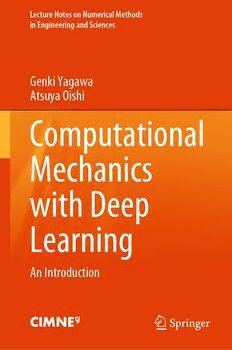
Computational Mechanics with Deep Learning: An Introduction PDF
Preview Computational Mechanics with Deep Learning: An Introduction
Lecture Notes on Numerical Methods in Engineering and Sciences Genki Yagawa Atsuya Oishi Computational Mechanics with Deep Learning An Introduction Lecture Notes on Numerical Methods in Engineering and Sciences SeriesEditor EugenioOñate ,JordiGirona,1,EdificiC1-UPC,UniversitatPolitecnicade Catalunya,Barcelona,Spain EditorialBoard CharbelFarhat,DepartmentofMechanicalEngineering,StanfordUniversity, Stanford,CA,USA C.A.Felippa,DepartmentofAerospaceEngineeringScience,Universityof Colorado,CollegeofEngineering&AppliedScience,Boulder,CO,USA AntonioHuerta,UniversitatPolitècnicadeCataluny,Barcelona,Spain ThomasJ.R.Hughes,InstituteforComputationalEngineering,UniversityofTexas atAustin,Austin,TX,USA SergioIdelsohn,CIMNE-UPC,Barcelona,Spain PierreLadevèze,EcoleNormaleSupérieuredeCachan,CachanCedex,France WingKamLiu,Evanston,IL,USA XavierOliver,CampusNordUPC,InternationalCenterofNumericalMethods, Barcelona,Spain ManolisPapadrakakis,NationalTechnicalUniversityofAthens,Athens,Greece JacquesPériaux,CIMNE-UPC,Barcelona,Spain BernhardSchrefler,MechanicalSciences,CISM-InternationalCentrefor MechanicalSciences,Padua,Italy GenkiYagawa,SchoolofEngineering,UniversityofTokyo,Tokyo,Japan MingwuYuan,Beijing,China FranciscoChinesta,EcoleCentraledeNantes,NantesCedex3,France This series publishes text books on topics of general interest in the field of computationalengineeringsciences. Thebookswillfocusonsubjectsinwhichnumericalmethodsplayafundamental role for solving problems in engineering and applied sciences. Advances in finite element, finite volume, finite differences, discrete and particle methods and their applicationstoclassicalsingledisciplinefieldsandnewmultidisciplinarydomains areexamplesofthetopicscoveredbytheseries. Themainintendedaudienceisthefirstyeargraduatestudent.Somebooksdefine thecurrentstateofafieldtoahighlyspecialisedreadership;othersareaccessibleto finalyearundergraduates,butessentiallytheemphasisisonaccessibilityandclarity. Thebookswillbealsousefulforpractisingengineersandscientistsinterestedin stateoftheartinformationonthetheoryandapplicationofnumericalmethods. · Genki Yagawa Atsuya Oishi Computational Mechanics with Deep Learning An Introduction GenkiYagawa AtsuyaOishi ProfessorEmeritus GraduateSchoolofTechnology UniversityofTokyoandToyoUniversity IndustrialandSocialSciences Tokyo,Japan TokushimaUniversity Tokushima,Japan ISSN 1877-7341 ISSN 1877-735X (electronic) LectureNotesonNumericalMethodsinEngineeringandSciences ISBN 978-3-031-11846-3 ISBN 978-3-031-11847-0 (eBook) https://doi.org/10.1007/978-3-031-11847-0 ©TheEditor(s)(ifapplicable)andTheAuthor(s),underexclusivelicensetoSpringerNature SwitzerlandAG2023 Thisworkissubjecttocopyright.AllrightsaresolelyandexclusivelylicensedbythePublisher,whether thewholeorpartofthematerialisconcerned,specificallytherightsoftranslation,reprinting,reuse ofillustrations,recitation,broadcasting,reproductiononmicrofilmsorinanyotherphysicalway,and transmissionorinformationstorageandretrieval,electronicadaptation,computersoftware,orbysimilar ordissimilarmethodologynowknownorhereafterdeveloped. Theuseofgeneraldescriptivenames,registerednames,trademarks,servicemarks,etc.inthispublication doesnotimply,evenintheabsenceofaspecificstatement,thatsuchnamesareexemptfromtherelevant protectivelawsandregulationsandthereforefreeforgeneraluse. Thepublisher,theauthors,andtheeditorsaresafetoassumethattheadviceandinformationinthisbook arebelievedtobetrueandaccurateatthedateofpublication.Neitherthepublishernortheauthorsor theeditorsgiveawarranty,expressedorimplied,withrespecttothematerialcontainedhereinorforany errorsoromissionsthatmayhavebeenmade.Thepublisherremainsneutralwithregardtojurisdictional claimsinpublishedmapsandinstitutionalaffiliations. ThisSpringerimprintispublishedbytheregisteredcompanySpringerNatureSwitzerlandAG Theregisteredcompanyaddressis:Gewerbestrasse11,6330Cham,Switzerland Preface ComputationalMechanics It is well known that various physical, chemical, and mechanical phenomena in natureandthebehaviorsofartificiallycreatedstructuresanddevicesaredescribed bypartialdifferentialequations.Whilepartialdifferentialequationsarerarelysolved by analytical methods except those under idealized and special conditions, such numericalmethodsasthefiniteelementmethod(FEM),thefinitedifferencemethod (FDM), and the boundary element method (BEM) can approximately solve most partial differential equations using a grid or elements that spatially subdivide the object.Thus,thedevelopmentofthesenumericalmethodshasbeenacentralissue incomputationalmechanics.Inthesemethods,thefinenessofthegridorelementsis directlyrelatedtotheaccuracyofthesolution.Therefore,manyresearchresources havebeendevotedtosolvinglargersimultaneousequationsfaster,andtogetherwith the remarkable advances in computers, it has become possible to solve very large problemsthatwereconsideredtobeunsolvablesomedecadesago. Nowadays,ithasbecomepossibletoanalyzeavarietyofcomplexphenomena, expandingtherangeofapplicationsofcomputationalmechanics. DeepLearning Ontheotherhand,theadvancesofcomputershavebroughtaboutsignificantdevel- opmentsinmachinelearning,whichaimsclassifyingandmakingdecisionsbythe process of finding inherent rules and trends in large amounts of data based on algorithmsratherthanhumanimpressionsandintuition. Feedforwardneuralnetworksareoneofthemostpopularmachinelearningalgo- rithms.Theyhavetheabilitytoapproximatearbitrarycontinuousfunctionsandhave beenappliedtovariousfieldssincethedevelopmentoftheerrorbackpropagation learning in 1986. Since the beginning of 21st century, they have become able to v vi Preface usemanyhiddenlayers,calleddeeplearning.Theirareasofapplicationshavebeen furtherexpandedduetotheperformanceimprovementbyusingmorehiddenlayers. ComputationalMechanicswithDeepLearning AlthoughthedevelopmentofcomputationalmechanicsincludingtheFEMhasmade itpossibletoanalyzevariouscomplexphenomena,therestillremainmanyproblems thataredifficulttodealwith.Specifically,numericalsolutionmethodssuchasthe FEMaresolidsolutionmethodsbasedonmathematicalequations(partialdifferential equations),sotheyareusefulwhenfindingsolutionstopartialdifferentialequations based on given boundary and initial conditions. However, it is not the case when estimating boundary and initial conditions from the solutions. In fact, the latter is oftenencounteredinthedesignphaseofartifacts. Inaddition,asdeeplearningandneuralnetworkscandiscovermappingrelations between data without explicit mathematical formulas, it is possible to find inverse mappingsonlybyswappingtheinputandoutput.Forthisreason,deeplearningand neuralnetworkshavebeenacceptedinthefieldofcomputationalmechanicsasan importantmethodtodealwiththeweakpointsofconventionalnumericalmethods suchastheFEM. They were mainly applied to such limited areas as the estimation of constitu- tivelawsofnonlinearmaterialsandnon-destructiveevaluation,butwiththerecent developmentofdeeplearning,theirapplicabilityhasbeenexpandeddramatically.In otherwords,afusionhasstartedbetweendeeplearningandcomputationalmechanics beyondtheconventionalframeworkofcomputationalmechanics. Readership Theauthors’previousbooktitledComputationalMechanicswithNeuralNetworks publishedin2021fromSpringercoversmostoftheapplicationsofneuralnetworks and deep learning in computational mechanics from its early days to the present togetherwithapplications ofothermachinelearningmethods.Itsconcisedescrip- tionsofindividualapplicationsmakeitsuitableforresearchersandengineerstoget anoverviewofthisfield. On the other hand, the present book, Computational Mechanics with Deep Learning:AnIntroduction,isintendedtoselectcarefullysomerecentapplicationsof deeplearningandtodiscusseachapplicationindetail,butinaneasy-to-understand manner. Sample programs are included for the readers to try out in practice. This bookisthereforeusefulnotonlyforresearchersandengineers,butalsoforawide rangeofreaderswhoareinterestedinthisfield. Preface vii StructureofThisbook The present book is written from the standpoint of integrating computational mechanicsanddeeplearning,consistingofthreeparts:PartI(Chaps.1–3)coversthe basics,PartII(Chaps.4–8)coversseveralapplicationsofdeeplearningtocomputa- tionalmechanicswithdetaileddescriptionsofthefieldsofcomputationalmechanics towhichdeeplearningisapplied,andPartIII(Chaps.9–10)describesprogramming, wheretheprogramcodesforbothcomputationalmechanicsanddeeplearningare discussedindetail.Theauthorshavetriedtomaketheprogramnotablackbox,but ausefultoolforreaderstofullyunderstandandhandletheprocessing.Thecontents ofeachchapteraresummarizedasfollows: PartIFundamentals: InChap.1,theimportanceofdeeplearningincomputationalmechanicsisgiven first and then the development process of deep learning is reviewed. In addition, variousnewmethodsusedindeeplearningareintroducedinaneasy-to-understand manner. Chapter2isdevotedtothemathematicalaspectsofdeeplearning.Itdiscussesthe forwardandbackwardpropagationsoftypicalnetworkstructuresindeeplearning, such as fully connected feedforward neural networks and convolutional neural networks,usingmathematicalformulaswithexamples,andalsolearningacceleration andregularizationmethods. Chapter 3 discusses the current research trends in this field based on articles published inseveral journals.Many ofthesearticlesarecompiled inthereference list,whichmaybeusefulforfurtherstudy. PartIICaseStudy: Chapter 4 presents an application of deep learning to the elemental integration processofthefiniteelementmethod.Itisshownthatageneral-purposenumerical integrationmethodcanbeoptimizedforeachintegrandbydeeplearningtoobtain betterresults. Chapter5introducesamethodforimprovingtheaccuracyofthefiniteelement solutions by deep learning, showing how deep learning can break the common knowledgethatafinemeshisessentialtoobtainanaccuratesolution. Chapter6isdevotedtoanapplicationofdeeplearningtothecontactpointsearch process in contact analysis. It deals with contact between smooth contact surfaces definedbyNURBSandB-splinebasisfunctions,showinghowdeeplearninghelps toaccelerateandstabilizethecontactanalysis. Chapter7presentsanapplicationofdeeplearningtofluiddynamics.Aconvolu- tionalneuralnetworkisusedtopredicttheflowfield,showingitsunparalleledspeedy calculationagainstthatofconventionalcomputationalfluiddynamics(CFD). Chapter 8 discusses further applications of deep learning to solid and fluid analysis. PartIIIComputationalProcedures: Chapter 9 describes some programs to be used for the application problems: Sect. 9.1 programs in the field of computational mechanics, such as the element viii Preface stiffnessmatrixcalculationprogram,andSect.9.2thoseinthefieldofdeeplearning, suchasthefeedforwardneuralnetwork,bothofwhicharegivenwithbackground mathematicalformulas. Chapter10presentsprogramsfortheapplicationofdeeplearningtotheelemental integrationdiscussedinChap.4.WiththeseprogramsandthosepresentedinChap.9, thereadersofthepresentbookcouldeasilytry“ComputationalMechanicswithDeep Learning”bythemselves. Tokyo,Japan GenkiYagawa Tokushima,Japan AtsuyaOishi May2022 Acknowledgements WewouldliketoexpressourgratitudetoY.Tamura,M.Masuda,andY.Nakabayashi for providing the data for Chap. 7. We also express our cordial thanks to all the colleaguesandstudentswhohavecollaboratedwithusoverseveraldecadesinthe fieldofcomputationalmechanicswithneuralnetworks/deeplearning:S.Yoshimura, M.Oshima,H.Okuda,T.Furukawa,N.Soneda,H.Kawai,R.Shioya,T.Horie,Y. Kanto,Y.Wada,T.Miyamura,G.W.Ye,T.Yamada,A.Yoshioka,M.Shirazaki,H. Matsubara, T. Fujisawa, H. Hishida, Y. Mochizuki, T. Kowalczyk, A. Matsuda, C. R.Pyo,J.S.Lee,andK.Yamada. We are particularly grateful to Prof. E. Oñate (CIMNE/Technical Univ. of Catalonia,Spain)forhiskindandimportantsuggestionsandencouragementsduring thepublicationprocessofthisbook. Tokyo,Japan GenkiYagawa Tokushima,Japan AtsuyaOishi ix
